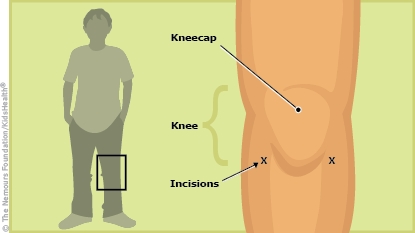After OCD Lesion Fixation of the Knee: How to Care for Your Child
Your child needs to rest the knee for a period of time so that it can heal from surgery. Under the surgeon's supervision, your child can eventually return to normal activities.


An osteochondritis dissecans (os-tee-oh-kon-DRY-tus DIS-uh-cans) (OCD) lesion is a small area of damaged bone and cartilage that can loosen from the rest of the bone.
Your child has had surgery to repair an OCD lesion in the knee joint. The surgeon secured the OCD lesion to the rest of the bone and removed some of the damaged tissue to help the area heal.

-
Give your child any medications as prescribed by your health care provider.
-
Follow the health care providers instructions about the removal of surgical dressings.
-
Your child should not take a bath, but can start showering on the third day after surgery. Wrap the knee in a plastic bag that is taped shut to keep the leg dry.
-
Apply a plastic bag of ice or a cold pack to the injured knee as often as the health care provider instructs. Keep the surgical dressing or a cloth between the ice or cold pack and the skin to prevent frostbite.
-
If your child has swelling, numbness, coldness, or tingling in the foot, loosen the bandage around the knee and have your child elevate the leg on a pillow to keep it above heart level.
-
Your child should do post-operative movement exercises as instructed by the health care provider.

-
If you haven't already, make a follow-up appointment with the surgeon.
-
Your child must use crutches and the brace or immobilizer whenever walking. Your child should not put any weight on the leg until told to do so by the health care provider.
-
Teens old enough to drive may do so once no longer taking narcotic pain medication. Braces should be unlocked or removed before driving.

Your child:
-
Is unable to urinate (pee) the evening of the surgery.
-
Has swelling or numbness in the leg that is not relieved by loosening the bandage and raising the leg.
-
Has a lot of fluid or blood draining from the surgical site.
-
Has a temperature above 101°F on two readings 2–3 hours apart more than 48 hours after surgery.
-
Has severe pain after 48 hours.

Your child: